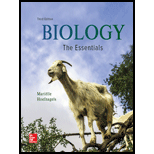
Biology: The Essentials
3rd Edition
ISBN: 9781260140705
Author: Marielle Hoefnagels
Publisher: Mcgraw-hill Higher Education (us)
expand_more
expand_more
format_list_bulleted
Concept explainers
Question
Chapter 16, Problem 1SL
Summary Introduction
To determine:
The production and use of biofuels in the United States and also the role of government, private industry, and scientists in promoting the production and use of biofuels.
Introduction:
Biofuels are the substitutes for fossil fuels and are derived from renewable animal and plant biomass. Biodiesel and ethanol are the two types of biofuels.
Summary Introduction
To determine:
Whether citizens have an ethical responsibility to use biofuels as a substitute for fossil fuels and provide a reason for the same.
Introduction:
Ethanol, biodiesel, and biogas are examples of biofuels. Ethanol is often made from corn or sugarcane. Biogas (methane) derives from animal manure and other digested organic material.
Expert Solution & Answer
Want to see the full answer?
Check out a sample textbook solution
Students have asked these similar questions
What is the structure and function of Eukaryotic cells, including their organelles? How are Eukaryotic cells different than Prokaryotic cells, in terms of evolution which form of the cell might have came first? How do Eukaryotic cells become malignant (cancerous)?
What are the roles of DNA and proteins inside of the cell? What are the building blocks or molecular components of the DNA and proteins? How are proteins produced within the cell? What connection is there between DNA, proteins, and the cell cycle? What is the relationship between DNA, proteins, and Cancer?
Why cells go through various types of cell division and how eukaryotic cells control cell growth through the cell cycle control system?
Chapter 16 Solutions
Biology: The Essentials
Ch. 16.1 - Prob. 1MCCh. 16.1 - Prob. 2MCCh. 16.1 - Prob. 3MCCh. 16.1 - Prob. 4MCCh. 16.1 - Prob. 5MCCh. 16.2 - Prob. 1MCCh. 16.2 - Prob. 2MCCh. 16.2 - Prob. 3MCCh. 16.3 - Describe the four groups of seedless vascular...Ch. 16.3 - Prob. 2MC
Ch. 16.3 - Prob. 3MCCh. 16.4 - Prob. 1MCCh. 16.4 - Prob. 2MCCh. 16.4 - Prob. 3MCCh. 16.4 - What happens during and after pollination in...Ch. 16.5 - Prob. 1MCCh. 16.5 - Prob. 2MCCh. 16.5 - Prob. 3MCCh. 16.5 - Prob. 4MCCh. 16 - Prob. 1MCQCh. 16 - Prob. 2MCQCh. 16 - Prob. 3MCQCh. 16 - Prob. 4MCQCh. 16 - Prob. 5MCQCh. 16 - Why do many ferns require a shady, moist habitat?...Ch. 16 - Prob. 7MCQCh. 16 - Prob. 8MCQCh. 16 - Prob. 9MCQCh. 16 - Prob. 10MCQCh. 16 - Prob. 1WIOCh. 16 - Prob. 2WIOCh. 16 - Prob. 3WIOCh. 16 - Prob. 4WIOCh. 16 - Prob. 5WIOCh. 16 - Prob. 6WIOCh. 16 - Prob. 7WIOCh. 16 - How do angiosperms differ from gymnosperms? How...Ch. 16 - The immature fruit of the opium poppy produces...Ch. 16 - Prob. 10WIOCh. 16 - Prob. 11WIOCh. 16 - Compare and contrast the life cycles of the four...Ch. 16 - Prob. 13WIOCh. 16 - Prob. 1SLCh. 16 - Review the relationship between natural selection...Ch. 16 - Prob. 2PITCh. 16 - Prob. 3PITCh. 16 - Describe the relationship between pollen and...
Knowledge Booster
Learn more about
Need a deep-dive on the concept behind this application? Look no further. Learn more about this topic, biology and related others by exploring similar questions and additional content below.Similar questions
- In one paragraph show how atoms and they're structure are related to the structure of dna and proteins. Talk about what atoms are. what they're made of, why chemical bonding is important to DNA?arrow_forwardWhat are the structure and properties of atoms and chemical bonds (especially how they relate to DNA and proteins).arrow_forwardThe Sentinel Cell: Nature’s Answer to Cancer?arrow_forward
- Molecular Biology Question You are working to characterize a novel protein in mice. Analysis shows that high levels of the primary transcript that codes for this protein are found in tissue from the brain, muscle, liver, and pancreas. However, an antibody that recognizes the C-terminal portion of the protein indicates that the protein is present in brain, muscle, and liver, but not in the pancreas. What is the most likely explanation for this result?arrow_forwardMolecular Biology Explain/discuss how “slow stop” and “quick/fast stop” mutants wereused to identify different protein involved in DNA replication in E. coli.arrow_forwardMolecular Biology Question A gene that codes for a protein was removed from a eukaryotic cell and inserted into a prokaryotic cell. Although the gene was successfully transcribed and translated, it produced a different protein than it produced in the eukaryotic cell. What is the most likely explanation?arrow_forward
- Molecular Biology LIST three characteristics of origins of replicationarrow_forwardMolecular Biology Question Please help. Thank you For E coli DNA polymerase III, give the structure and function of the b-clamp sub-complex. Describe how the structure of this sub-complex is important for it’s function.arrow_forwardMolecular Biology LIST three characteristics of DNA Polymerasesarrow_forward
arrow_back_ios
SEE MORE QUESTIONS
arrow_forward_ios
Recommended textbooks for you
 Concepts of BiologyBiologyISBN:9781938168116Author:Samantha Fowler, Rebecca Roush, James WisePublisher:OpenStax College
Concepts of BiologyBiologyISBN:9781938168116Author:Samantha Fowler, Rebecca Roush, James WisePublisher:OpenStax College Human Biology (MindTap Course List)BiologyISBN:9781305112100Author:Cecie Starr, Beverly McMillanPublisher:Cengage Learning
Human Biology (MindTap Course List)BiologyISBN:9781305112100Author:Cecie Starr, Beverly McMillanPublisher:Cengage Learning Biology 2eBiologyISBN:9781947172517Author:Matthew Douglas, Jung Choi, Mary Ann ClarkPublisher:OpenStax
Biology 2eBiologyISBN:9781947172517Author:Matthew Douglas, Jung Choi, Mary Ann ClarkPublisher:OpenStax Comprehensive Medical Assisting: Administrative a...NursingISBN:9781305964792Author:Wilburta Q. Lindh, Carol D. Tamparo, Barbara M. Dahl, Julie Morris, Cindy CorreaPublisher:Cengage Learning
Comprehensive Medical Assisting: Administrative a...NursingISBN:9781305964792Author:Wilburta Q. Lindh, Carol D. Tamparo, Barbara M. Dahl, Julie Morris, Cindy CorreaPublisher:Cengage Learning


Concepts of Biology
Biology
ISBN:9781938168116
Author:Samantha Fowler, Rebecca Roush, James Wise
Publisher:OpenStax College

Human Biology (MindTap Course List)
Biology
ISBN:9781305112100
Author:Cecie Starr, Beverly McMillan
Publisher:Cengage Learning

Biology 2e
Biology
ISBN:9781947172517
Author:Matthew Douglas, Jung Choi, Mary Ann Clark
Publisher:OpenStax

Comprehensive Medical Assisting: Administrative a...
Nursing
ISBN:9781305964792
Author:Wilburta Q. Lindh, Carol D. Tamparo, Barbara M. Dahl, Julie Morris, Cindy Correa
Publisher:Cengage Learning

Microbial Nutrition and Growth; Author: Scientist Cindy;https://www.youtube.com/watch?v=rK3UkyWjkl8;License: Standard YouTube License, CC-BY